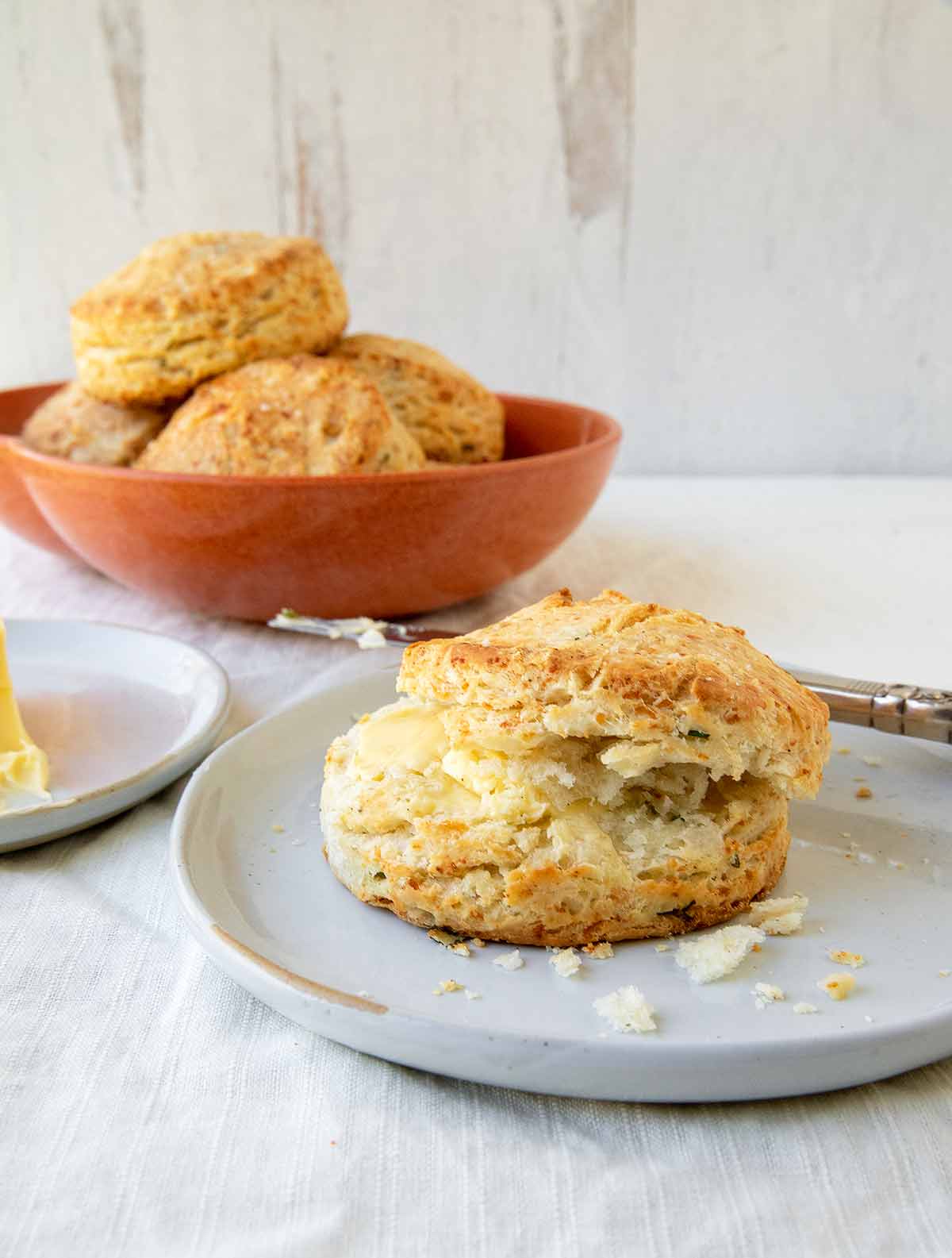
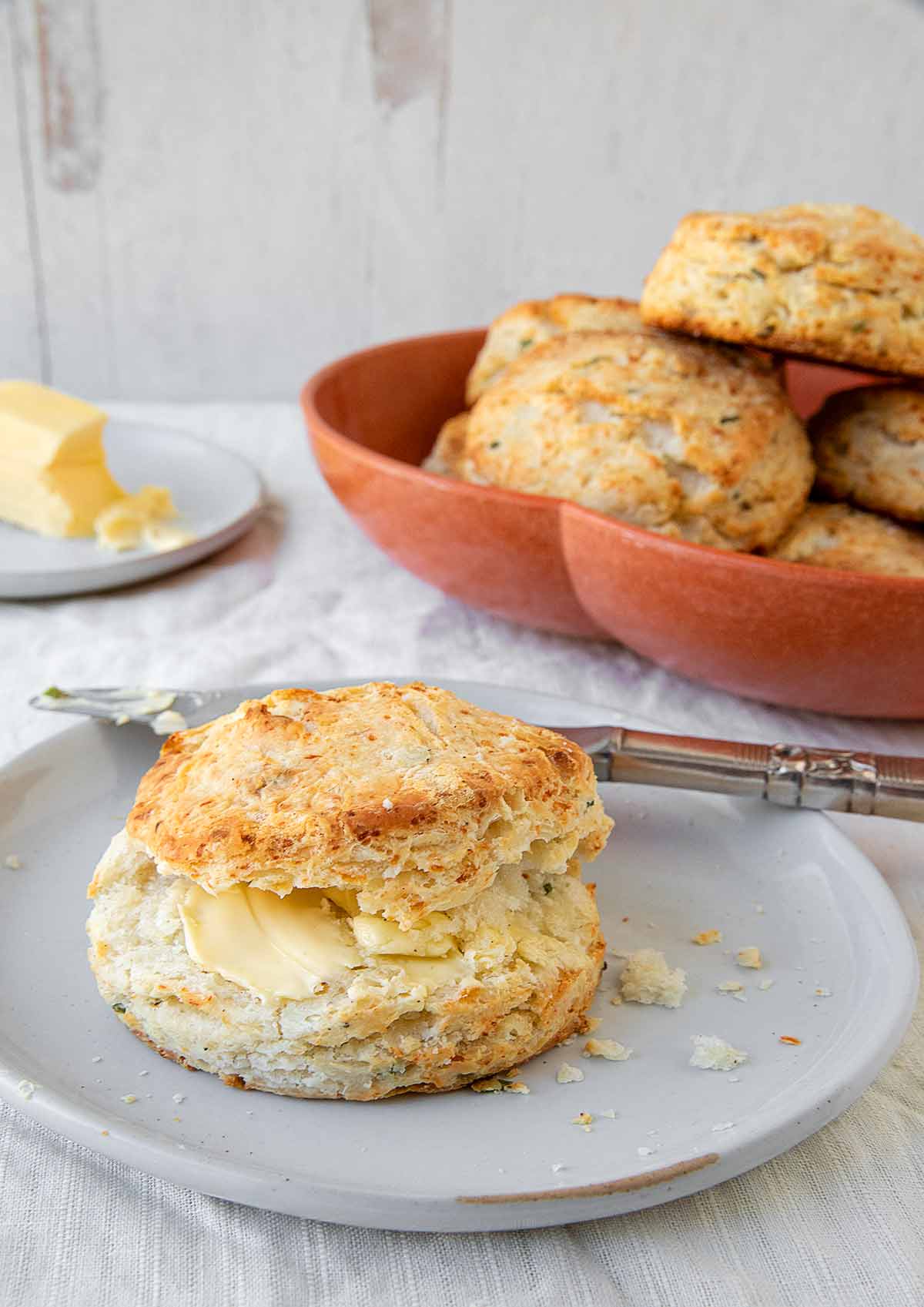
I love reaching for chives to lend a pop of nice green flavor (and color) to these biscuits. You could, of course, omit the chives, which would leave you with an otherwise perfectly classic, flaky buttermilk biscuit that gets a salty tang from the Parmesan. Either way, these are everything you could want on a cool day, whether you’re enjoying them on their own or using them to sop up a hearty stew.–John Kanell

Why Our Testers Loved This
Our recipe testers happily devoured these enormous homemade buttermilk biscuits. They found them “tender, flavorful, and simple to put together.” Deb Lynch was impressed that the directions were “very easy to understand and follow,” even for a novice biscuit maker.
Miriam summed it up when she wrote, “Sometimes I find myself daydreaming about biting into the perfectly crisp outside of a buttery biscuit, revealing tender, fluffy layers that flake apart. Lucky for me (and really for the rest of the world), these savory Parmesan biscuits with chives offer all that and more!”
Notes on Ingredients
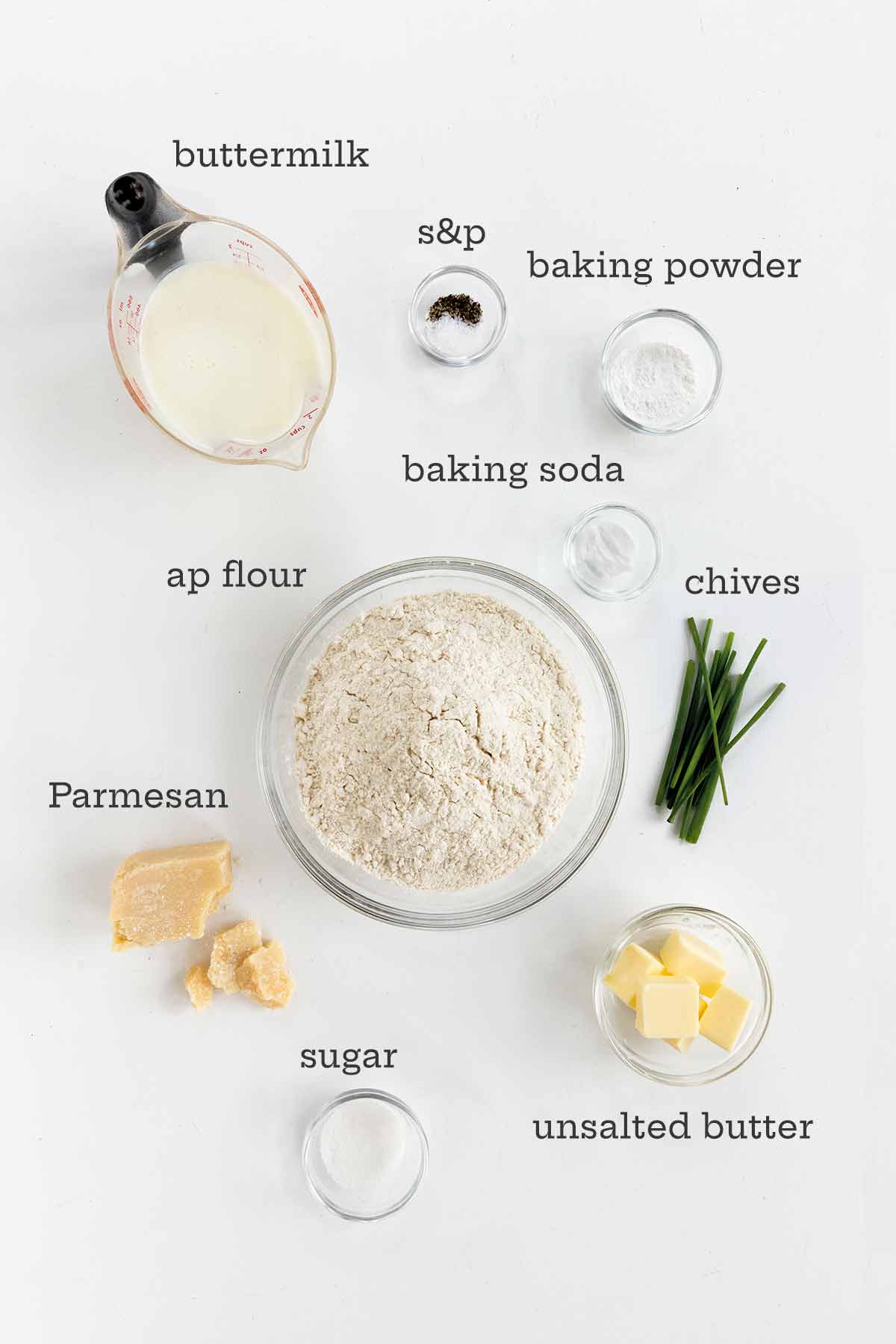
- Butter–Use the best-quality butter that you can find. European-style butter works beautifully here.
- Chives or scallions–The chives or scallions give these biscuits a decidedly savory flavor, but you can omit them if you prefer a more classic Parmesan cheese buttermilk biscuit.
- Buttermilk–If you don’t have buttermilk, stir together 1 1/3 cups whole milk and 4 teaspoons lemon juice or white vinegar. Let stand for 5 minutes before using.
Step-by-Step Instructions
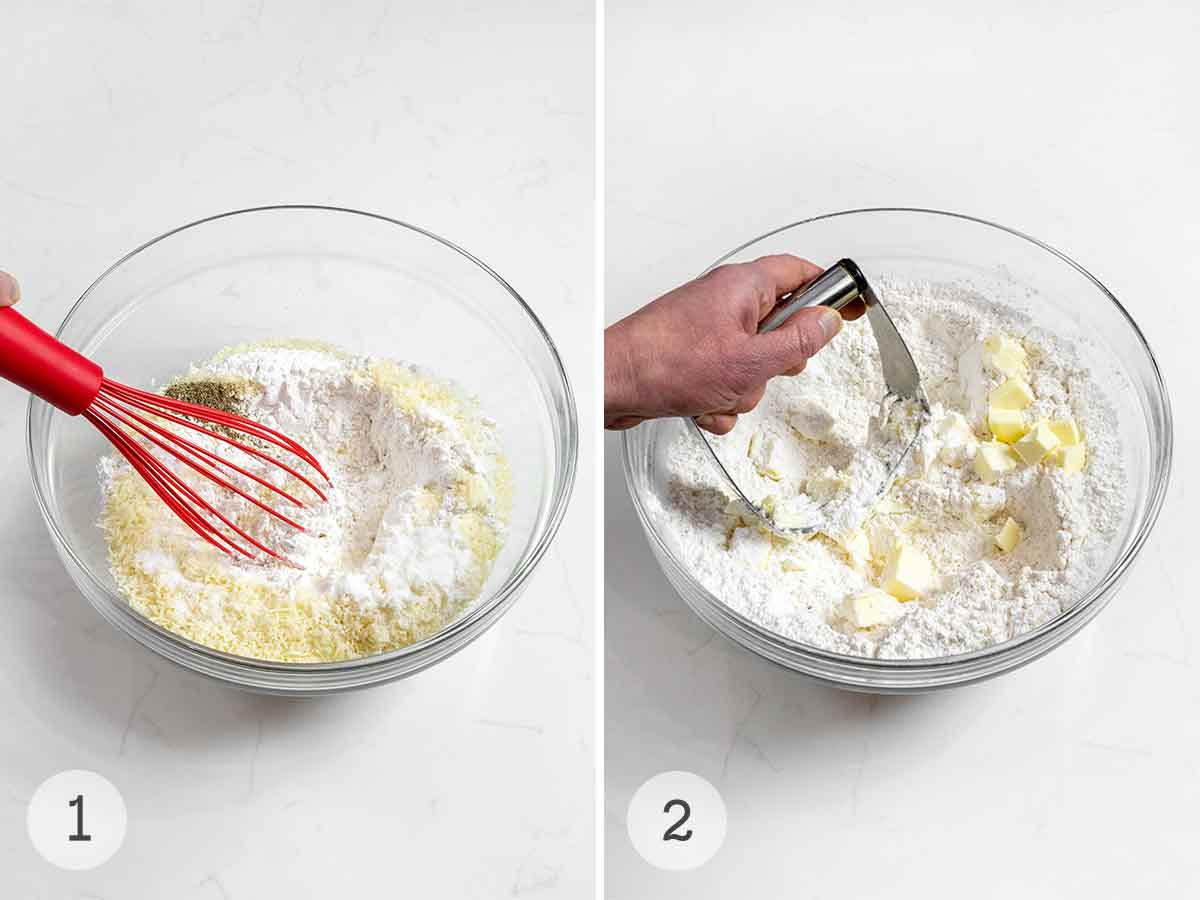
- Freeze the butter until cold. Line a large baking sheet with parchment paper. Whisk the flour, cheese, baking powder, sugar, salt, pepper, and baking soda together in a large bowl.
- Rub the butter into the dry ingredient mixture until the pieces of butter are pea-sized.
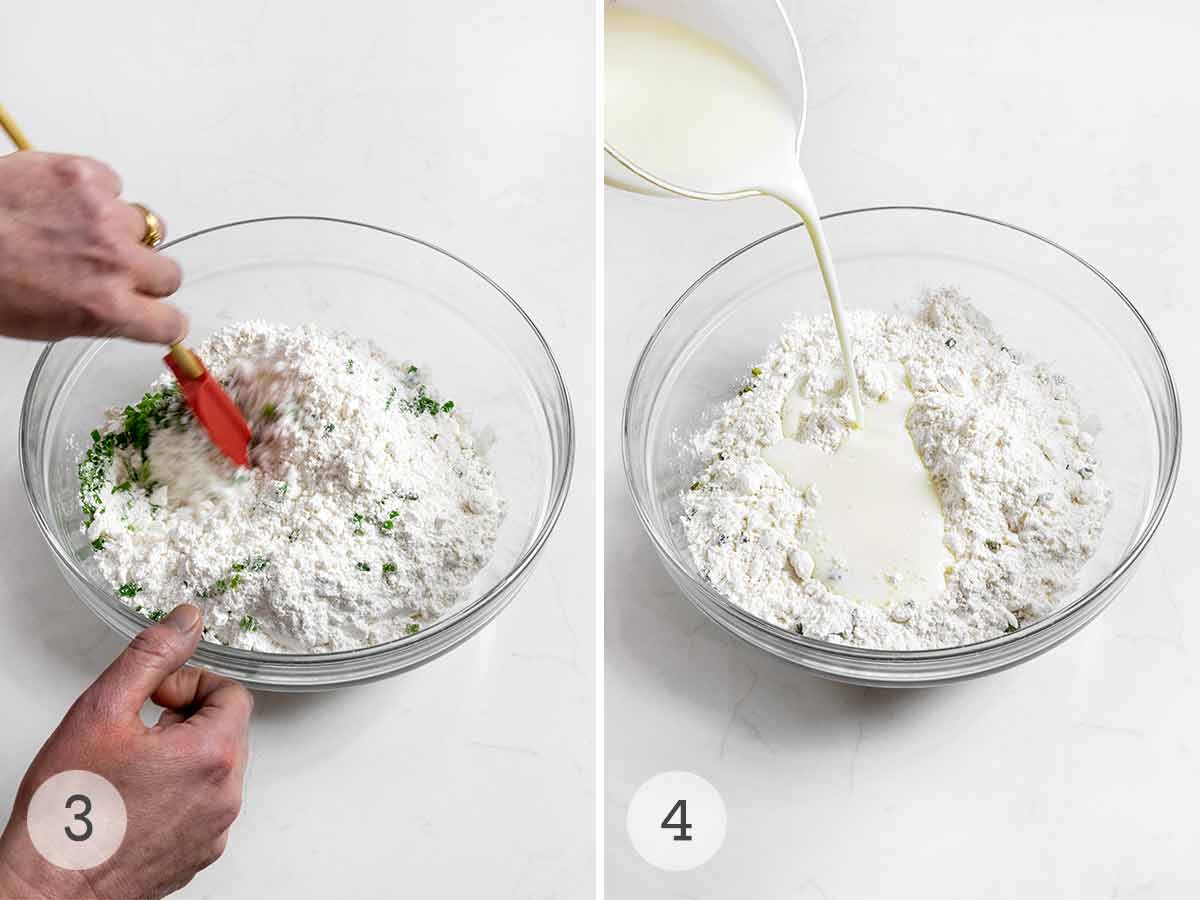
- Stir in the chives.
- Fold the buttermilk into the dry ingredients.
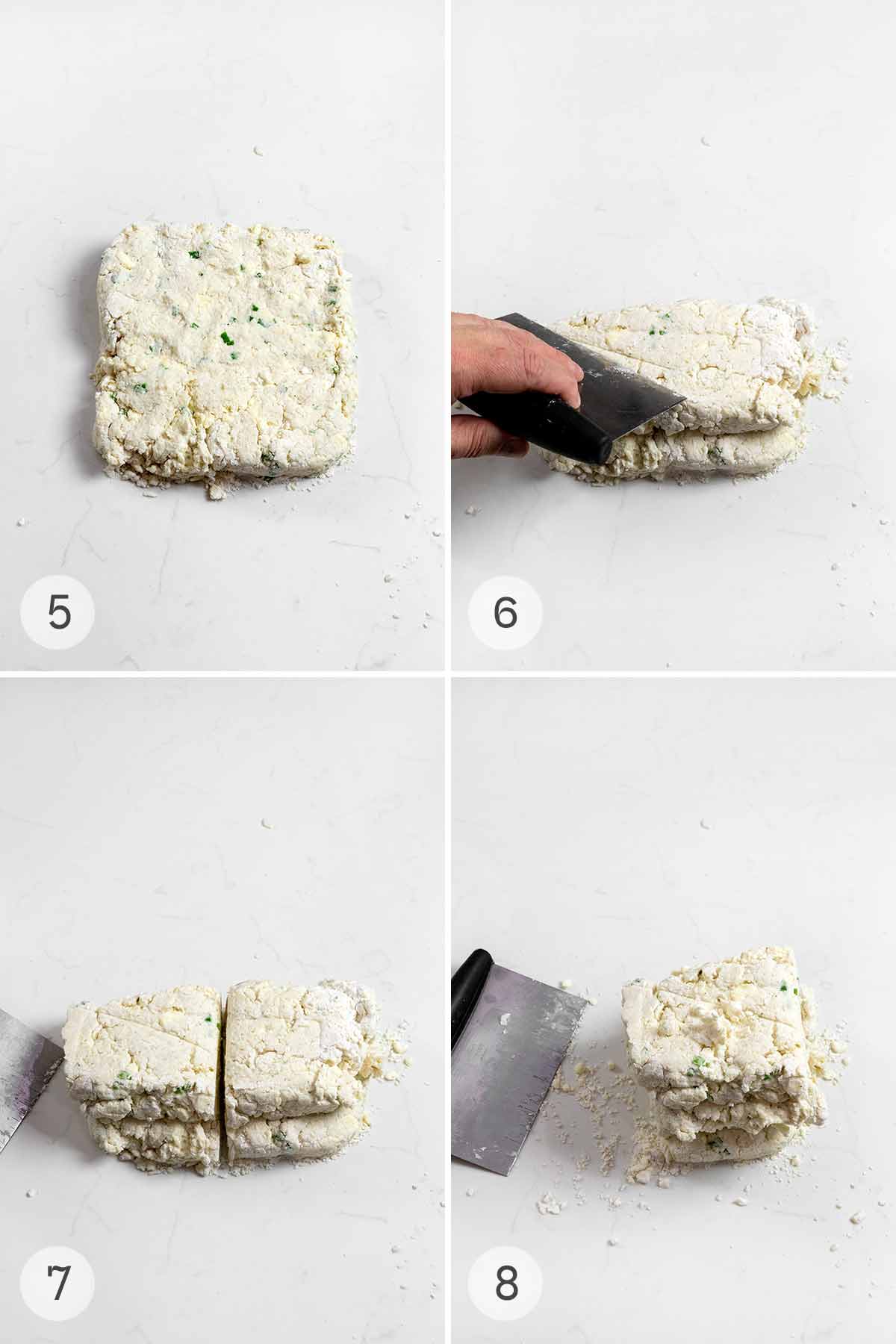
- Pat the dough into a 1-inch-thick square on a floured surface.
- Fold the dough in half.
- Cut the dough in half.
- Stack the two halves on top of each other. Pat the dough back into a 1-inch-thick square. Repeat this process 3 times.
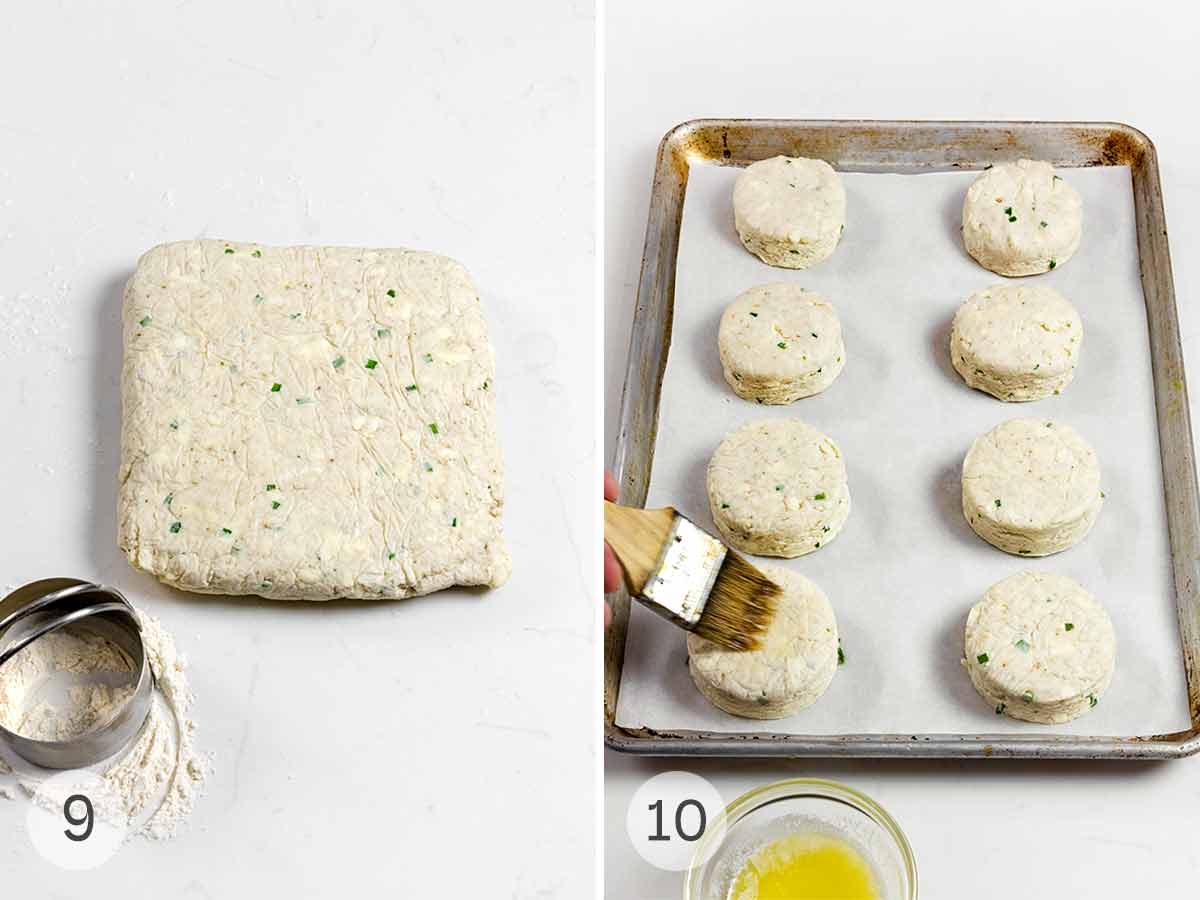
Want to Save This?
- Cut the dough into 3 1/2-inch biscuits. Reroll and cut scraps as needed. Freeze the biscuits for 10 minutes.
- Heat oven to 425°F. Brush the chilled biscuits with melted butter and sprinkle with salt. Bake until golden.
Common Questions
Yes, biscuits generally freeze well. Cool the baked biscuits completely, then wrap them in heavy-duty foil or store them in a resealable freezer bag, being sure to remove all of the air from the bag. Reheat in a 300°F oven until warmed through.
Buttermilk is frequently used for making biscuits because the acid in buttermilk reacts with baking soda, which makes the biscuits rise higher than if they’d been made with regular milk. The buttermilk also contributes to a sturdier texture and slightly darker edges after baking.
Yes. To save time, you can use a bench scraper to divide the dough into eight rectangles. If you want round biscuits but don’t have a cutter, use an upside-down glass to cut the biscuits.
A good biscuit is welcome any time of the day, and the testers found that they were equally welcome when served alongside soups and stews or as a side to a protein, like a steak or chicken. They also found that the biscuits worked wonderfully as the base for a breakfast sandwich or eggs Florentine. They are best enjoyed with a schmear of butter and a sprinkling of flaky salt.
Pro Tips & Troubleshooting
- When you start shaping and folding the biscuit dough, the mixture will still be very crumbly and may not fully hold together. Don’t be tempted to add more liquid – the dough will come together as you continue folding, stacking, and patting it out.
- For best results, keep your ingredients and tools cold.
- To achieve flaky edges on your biscuits, don’t twist the cutter as you cut the biscuits.
- Store leftover biscuits in a resealable bag at room temperature for up to 1 day. Rewarm in a low oven until heated through.

Write a Review
If you make this recipe, or any dish on LC, consider leaving a review, a star rating, and your best photo in the comments below. I love hearing from you.–David
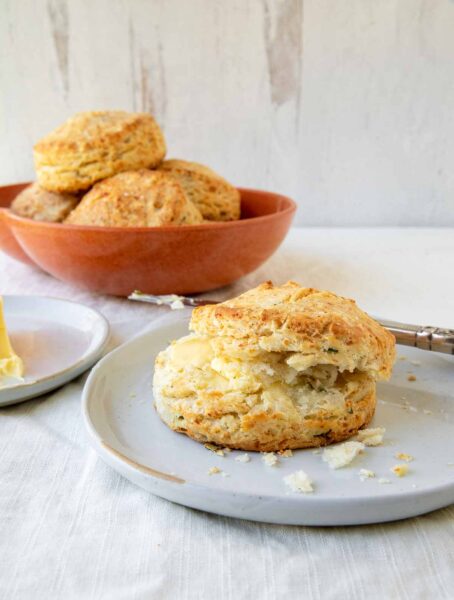
Savory Parmesan Cheese Biscuits
Ingredients
- 1 1/2 sticks (6 oz) cold unsalted butter, cubed
- 4 cups all-purpose flour, plus more for the biscuit cutter
- 1 cup grated Parmesan cheese
- 1 tablespoon baking powder
- 1 tablespoon granulated sugar
- 1 1/2 teaspoons kosher salt
- 1 teaspoon freshly ground black or white pepper
- 1/4 teaspoon baking soda
- 1/4 cup minced fresh chives or scallions
- 1 1/2 cups cold whole-milk buttermilk
- 2 tablespoons (1 oz) unsalted butter, melted
Instructions
- Place the cubed butter in the freezer for 10 minutes to chill. Line a rimmed baking sheet with parchment paper.
- In a large bowl, whisk together the flour, cheese, baking powder, sugar, salt, pepper, and baking soda.
- Add the cold butter and toss to coat the pieces with flour. Using a pastry blender or briefly squeezing the pieces of butter between your thumb and forefinger, cut the butter into the flour mixture until the butter pieces are between the size of peas and almonds.
- Stir in the chives.
- Add the buttermilk and fold the mixture together with a silicone spatula until the dough is mostly combined but still crumbly. Turn out the dough on a clean work surface and pat it into a 1-inch-thick (25 mm) square.
- Using a bench scraper or large knife, fold the dough in half like a book. (It may still be very crumbly, and that’s okay.) Cut the dough in half and stack the two halves on top of each other. Pat the dough back into a 1-inch-thick (25 mm) square. Repeat this process three more times, folding, stacking, and patting back down.
- Use a 3 1/2-inch (10 cm) round cookie cutter dipped in flour to cut out the biscuits. Reroll and cut any scraps as needed.
☞ TESTER TIP: Using a 3 1/2-inch cutter makes very large biscuits. If you prefer smaller biscuits, use a smaller cutter or an upside-down glass.
- Place the biscuits on the prepared baking sheet 1 inch (25 mm) apart and freeze for 10 minutes or refrigerate for 30 minutes.
- Preheat the oven to 425ºF (220°C).
- Brush the chilled biscuits with the melted butter and sprinkle with the flaky salt, if desired. Bake until the tops are golden brown and the sides are very flaky, 18 to 23 minutes.
- Serve warm with butter.
Notes
- Don’t add extra liquid–When you start shaping and folding the biscuit dough, the mixture will still be very crumbly and may not fully hold together. Don’t be tempted to add more liquid–the dough will come together as you continue folding, stacking, and patting it out.
- Keep it cold–For best results, keep your ingredients and tools cold. If the dough becomes too soft and sticky, pop it into the fridge for 10 minutes before working on it.
- Don’t twist the biscuit cutter–To achieve flaky edges on your biscuits, don’t twist the cutter as you cut the biscuits.
- Make your own buttermilk–If you don’t have buttermilk, stir together 1 1/3 cups whole milk and 4 teaspoons lemon juice or white vinegar. Let stand for 5 minutes before using.
- Storage–Store leftover biscuits in a resealable bag at room temperature for up to 1 day. Rewarm in a low oven until heated through.

Explore More with AI
Nutrition
Nutrition information is automatically calculated, so should only be used as an approximation.
Recipe Testers’ Reviews
These Parmesan biscuits were tender and flavorful, and simple to put together. I used scallions instead of chives because I had them on hand. I served them with grilled steak, baked yams, and sliced tomatoes from our garden.
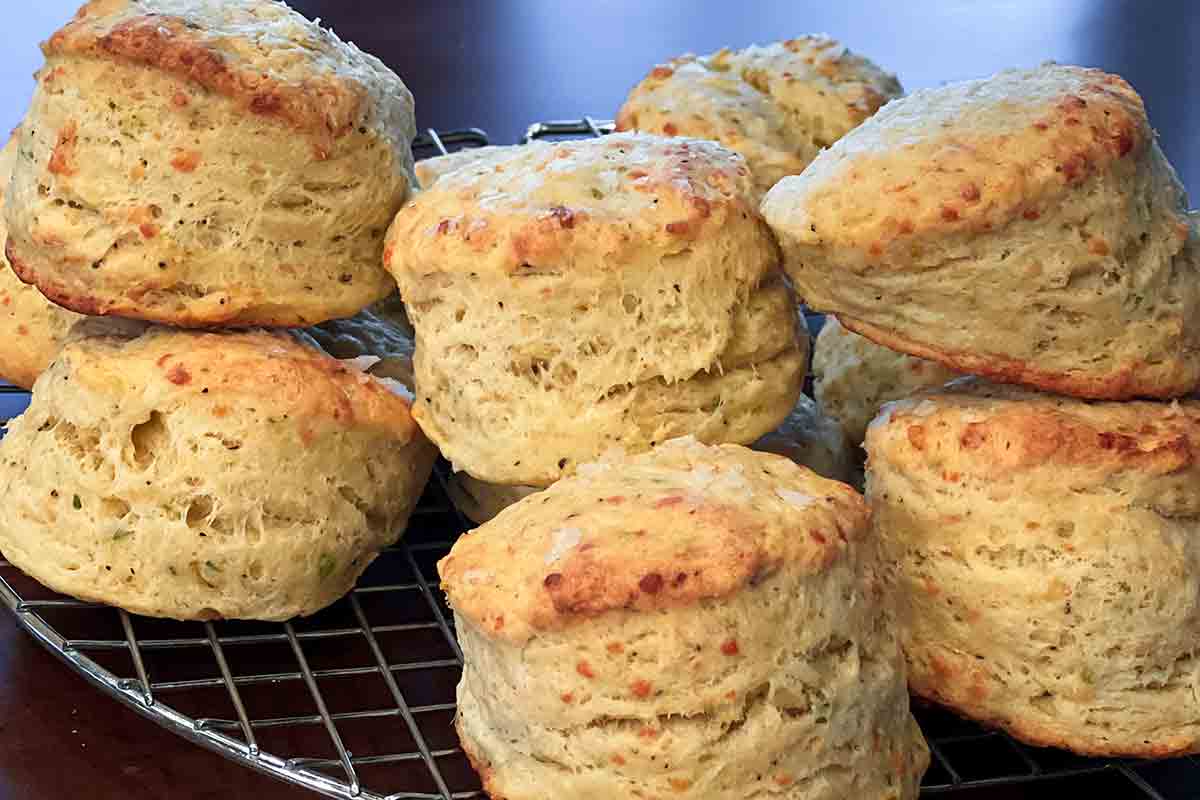
I was concerned about the final product having used all European-style butter. The biscuits did rise nicely, but the texture was less flaky than the biscuits I make with American-style butter and bacon fat (or lard).
I used a large Silpat to roll out the dough. Makes it easier to work with, not needing any extra flour. I was able to get 11 biscuits in total. I rested the unbaked biscuits in the fridge for an hour because of my schedule (they would have been ready in thirty minutes), then brushed them with butter and finished with Maldon flake salt before baking.
Although still yummy and beautiful, they were a little lopsided, so next time, I’ll place them closer together.
Biscuits are one of my favorite things, and this one is made with delicious European butter. As one of my friends recommends, keep everything cold, including the mixing bowl, baking sheet, and all the dry ingredients.
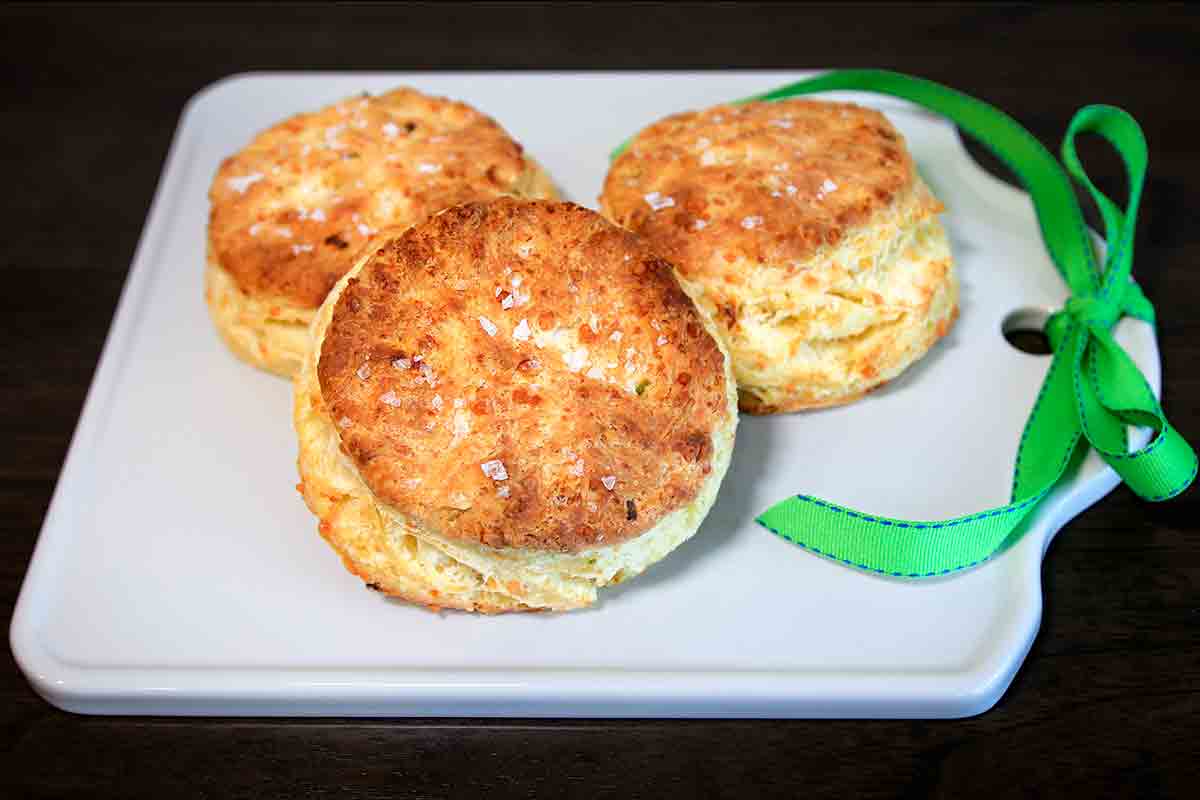
The white pepper provides an earthy, umami flavor that goes well with cheese and chives. These are large biscuits, and the only time I’ve only eaten one biscuit. They would be great for a hearty egg Benedict.
The author mentions how good and comforting these savory biscuits with chives would be in cooler weather, but I think these would be outstanding anytime. They are a nice tweak on traditional buttermilk biscuits.
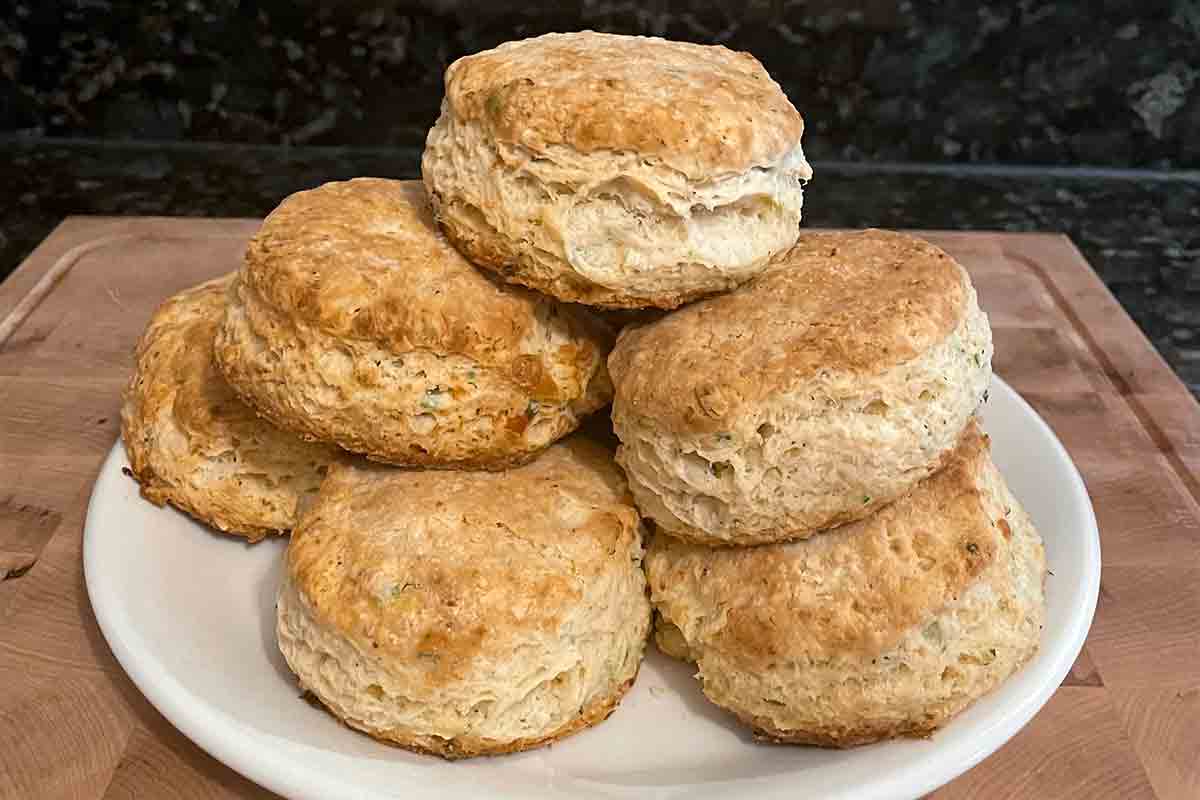
The Parmesan is the most forward flavor to me. It adds a nice nuttiness, especially to the browned biscuit tops and bottoms. I would go with scallions for a more “oniony” flavor, but the chives are subtle and look pretty.
As a Southerner, I can see using these cut into small bite-size biscuits before being baked and filled with country ham for any number of gatherings: showers, tailgating, parties, etc. These are giant biscuits. My recipe yielded 9 biscuits using the stated size cutter.
Leftover, they made excellent breakfast sandwiches with sausage and egg! They are loaded with butter, but a nice pat of butter is so good on a hot biscuit. Add a big spoon of jam for salty-sweet perfection!
Full of flavor, these biscuits lose only a little of their flakiness with the extra moisture from the chives and cheese. It amazes me every time how biscuit dough is so alternately crumbly and wet yet comes together perfectly during the folding process without even a dusting of extra flour on the counter.
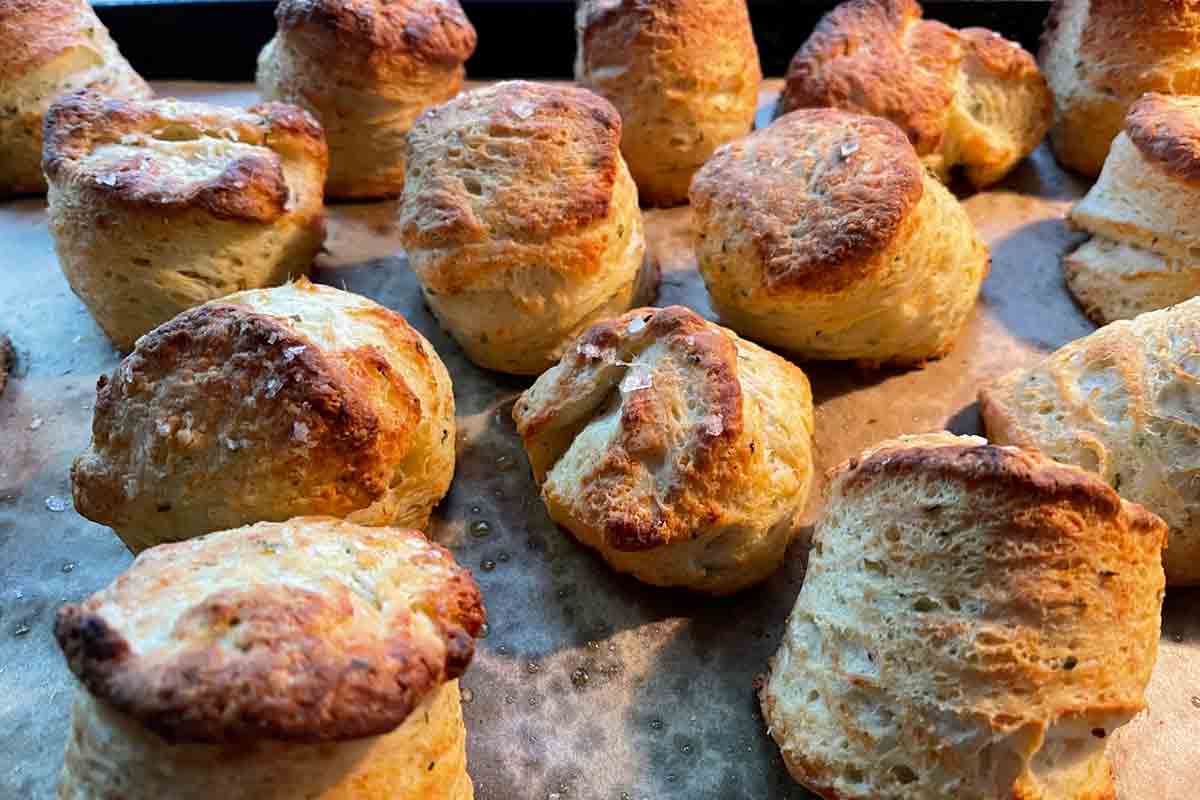
I made smaller versions (6 cm) to go with our dinner salads and baked them for 18 minutes, producing a nice dark golden color. Maybe due to the smaller size, they rose in the oven higgledy-piggledy rather than straight up. We especially liked the crispy exteriors and plan to make these often.
New to making biscuits? Long-time baker? I recommend trying this Parmesan cheese biscuit recipe as much to learn the technique for creating a classic biscuit as for the savory result.
I am a novice biscuit maker, and I found the recipe directions very easy to understand and follow. Happily, I did achieve a high-rise biscuit with flaky layers. In our house, we use biscuits as the base for eggs Benedict instead of English muffins, and including Parmesan and chives make these all the better.
This was my first time making savory biscuits, and I’m glad I tried these ones, as they were delicious and pretty easy to make. I struggled a little with folding the dough into a book as I didn’t have a bench scraper or large knife, so I can see why those would be great tools.
However, the biscuits still turned out great. Nice crust with a flaky center. They went perfectly with the slow cooker beef stew I made.
Yum, yum, yum!! I have tested a couple of other biscuit recipes before, but these are by far my favorite. The folding method resulted in biscuits that baked up incredibly high and flaky.
I served them at a brunch, and everyone raved about them and asked for seconds. My biscuits didn’t have a strong chive flavor, but I liked the green flecks they provided from a presentation perspective. I will definitely be making these again!
I served the biscuits with crabapple jam, a quiche Lorraine, and a watermelon, cucumber, and feta salad.
These delectable savoury biscuits served up everything that you could possibly ask for. Between the flaky layers, tangy parmesan flavours, and subtle hints of chive, these made a beautiful addition to a cozy dinner. Enjoyed alongside braised chicken thighs and mustard-coated carrots, my family savoured the biscuits and then went back to the leftovers for breakfast.
I found the recipe practically flawless, and I was pleased to have found a biscuit dough of such ideal consistency that made the baking process as simple as possible.
Working quickly and avoiding re-rolling the dough too many times is essential. If the butter warms up, it can cause the biscuits to spread considerably.
Regardless, these were magnificent, especially when paired with a little drizzle of honey for an added kick of sweetness.
The finished biscuits were soft and cheesy, and the chive flavour was evident. The cheese biscuits held their shape well and didn’t crumble when eaten. I would make these again and might make them my more normal size to get more biscuits out of the dough. My biscuits did not look as well layered as the picture suggests, but they were still very good.
I had fresh-picked corn for corn chowder and thought these Parmesan cheese biscuits would make a wonder accompaniment for dinner with the weather getting cooler.
Instead of using a biscuit cutter and having to pat dough again, I cut them into squares with a bench scraper. This is a trick I adopted several years ago and use with scone recipes, too.
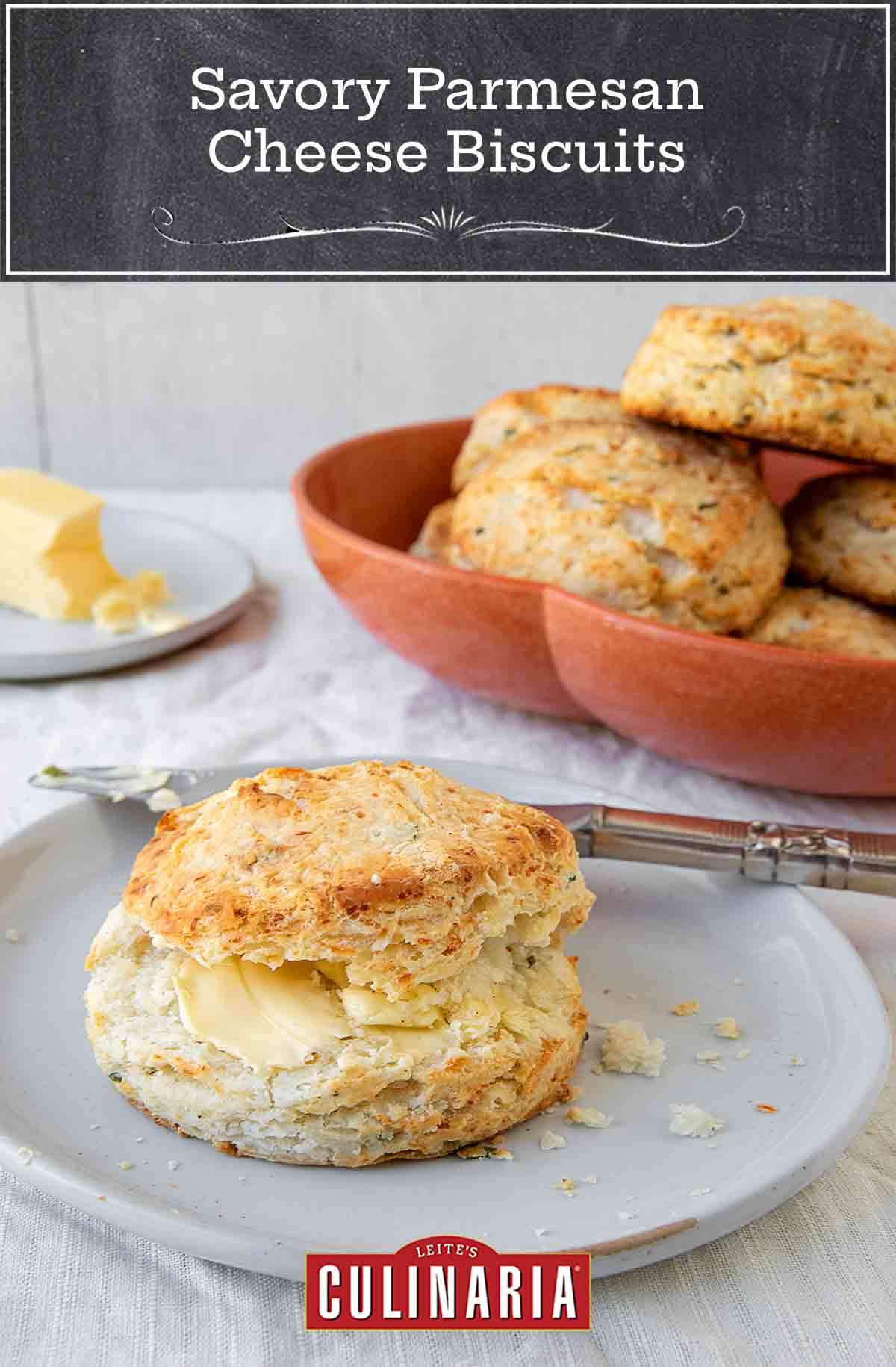
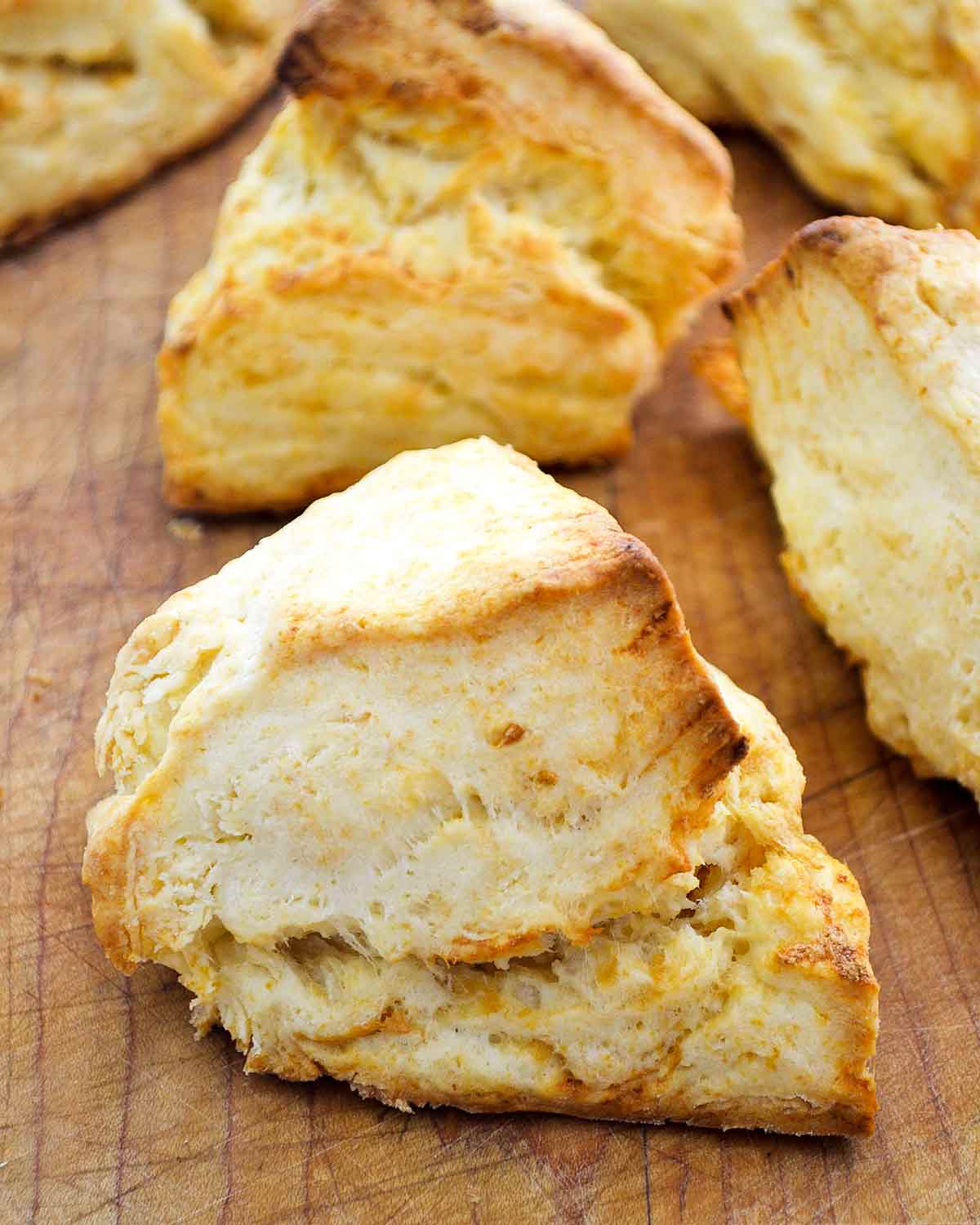
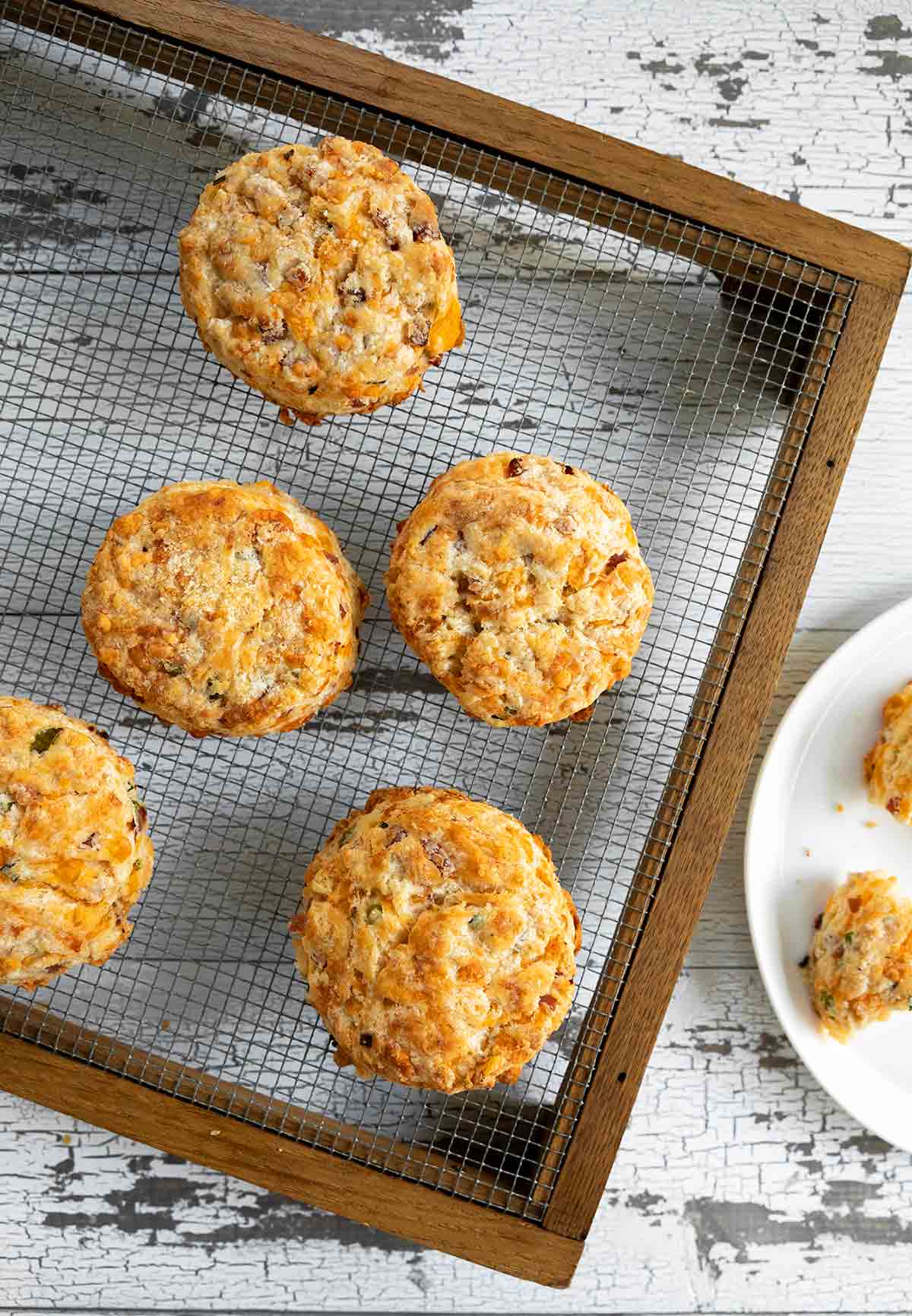

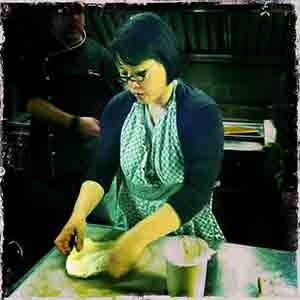















How do I adjust this recipe if I already have self-rising flour?
Lisa, we didn’t test this with self-rising flour, so we can’t say how it will turn out, but if you’re using self-rising flour, then omit the baking powder and salt in step 2 and use 4 cups plus 1 1/2 tablespoons of the self-rising flour in place of the all-purpose flour.
Thanks for the heads up. I will give it a try. 🙂
You’re welcome, Lisa. Do let us know how they turn out.